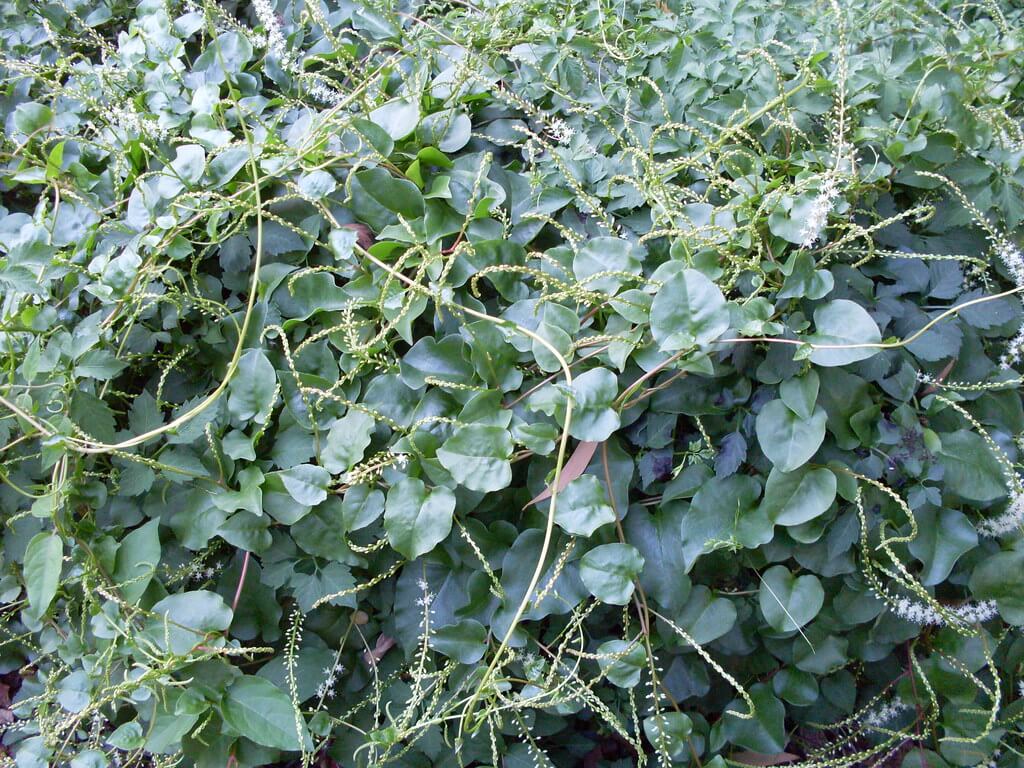What Does It Look Like?
What is it?
Madeira Vine (Anredera cordifolia) is a long-lived woody vine that grows twinning and climbing over trees and shrubs, and can reach to 20-30 metres tall and wide. Madeira Vine propagates (produces new plants) from underground tubers (rhizomes), and aerially fleshy bulbils (or bulblet) produced along the stems. It is evergreen in tropical, sub-tropical and warm temperate areas, and semi-deciduous to deciduous in colder climates. Leaves are alternately arranged (one leaf per stem joint (node)) along the stem, sub-sessile (with a very small leaf stalk), slightly fleshy, bright green, normally glossy above, glabrous (hairless), and heart-shaped or broadly ovate (triangular in outline), 20-120 mm long, 15-100 mm wide. The twinning stems are slender at first, glabrous (hairless), with young stems often green with a reddish colour, growing in twining fashion, becoming thick and rope-like and covered with greyish-brown smooth bark as they mature. Each leaf axil (where the leaf joins the stem) is capable of producing a small irregular fleshy aerial bulbil. These bulbils are normally produced on older woody aerial stems, with each starting as a small swelling, expanding and multiplying in to a mass of fleshy wart-like greyish-brown or greenish bulbils, reaching 10-100 mm long, in some cases exceeding the size of a large fist. Bulbils are normally dislodged from the parent plant when bumped or knocked by animals or people.
The flowers are produced in racemes (cylindrical flowering heads) can be simple but also show some branching, from 60-200 mm long, sometimes to 300 mm long. Madeira Vine has masses of fragrant, drooping, small white or cream flowers to 5 mm in diameter. The flowers are star shaped and have 5 petals and 5 stamens. The petals are 2-3 mm long, fleshy, persistent and turn dark brown or black in colour with age, and surround the small fruit.
Viable seeds are generally not produced in Australia (ISSG 2006; Navie 2004).
Recognition: This species can normally be recognised by the combination of the following characters; twinning woody vine, semi fleshy hairless glossy above green leaves, cylindrical flowering heads with 100s of small cream flowers, and the key to identifying the plant are the fleshy areal bulbils along the stem, present all year round.
For further information and assistance with identification of Madeira Vine contact the herbarium in your state or territory.
Flower colour
White or cream
Growth form (weed type/habit)
Vine
Where it currently grows? Preferred habitat
Madeira Vine is found mostly in wetter (humid) temperate, sub-tropical and tropical regions. It is a weed of rain-forest margins, moist woodlands, bushland, waterways, waste areas, gardens, parks, plantation crops (e.g. sugar cane) and roadsides (Navie 2004). In cooler temperate areas it grows in higher rainfall areas especially near water or in riparian situations in areas not fully exposed to the hot dry summer sun.
Are there similar species?
Madeira Vine is a very distinct species and is rarely confused with other species. Japanese Honeysuckle (Lonicera japonica) has a similar habit and grows in similar environments; however it has oppositely arranged leaves (leaves in pairs at the same stem joint (node)) and larger flowers that are borne in small clusters (Navie 2004).
Some weedy vines are superficially similar to Madeira Vine because of their fleshy leaves. These are:
Cape Ivy (Delairea odorata), and the climbing groundsels (Senecio angulatus and Senecio tamoides).
A native vine, Climbing Lignum (Meuhlenbeckia adpressa) has slightly fleshy leaves which may also have leaves with a heart-shaped (cordate) base like Anredera.
Some native vines have glossy, but not fleshy, heart-shaped leaves, for example, Snake Vine (Stephania japonica), Pearl Vine (Sarcopetalum harveyanum), Round-leaf Vine (Legnephora moorei ) and Giant Pepper Vine (Piper hederaceum). Giant Pepper Vine clings to tree trunks with small suckers of aerial roots, unlike Madeira Vine which twines (Miles undated).































